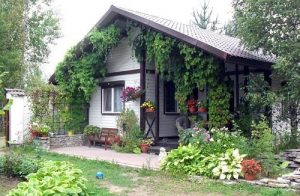In Russia, gardening is a serious family matter. It is more than a hobby that one does in one’s spare time. The dacha which takes the role of a country house for Russians, also includes a garden where people grow their own food instead of decorative plants. Russians of various professions will go back to their Dacha for weekends or seasonal holiday, then work hard in their garden. The result is really awesome. It is said that Russian dacha gardeners (dachniks) provide almost half of Russia’s food supply!

This is not mere rumor. According to a report by Russian Statistics Service in 2011, dacha gardens produced more than 80 percent of Russia’s fruit and berries, over 66 percent of the vegetables, almost 80 percent of the potatoes, and nearly 50 percent of the nation’s milk; most are consumed freshly. In other words, these small scale gardens not only help the country to be self-sufficient in food production and free of corporate farms exploitation, but also reduce family expenses and improve quality of life. Extremely awesome, don’t you think so!?
Related:
Due to its highly successful outcome, many other countries looks up to the Russian gardening lifestyle as an exemplary case study. You can also emulate it and invite your family to join in the fun easily. Here is a simple guide on how you can adopt Russian gardening lifestyle to your home.
1. Prepare A Little Plot of Land
The key to a Russian gardening lifestyle is a small plot of land. In fact, dacha plots are usually not more than 600 m2, including house and garden area. It means, there is no way to grow edible plants in a large scale. However, the garden can produce enough resources for you and your family.
If you don’t own any plot of land because you are living in an apartment or a crowded housing complex, look for a small house in faraway village. It should be an investment that is cheaper than the cost of living in the big city. It can be your own “country house” where you take a fresh breath away from city’s fumes as well as interact with nature and produce your own favorite foods.
If buying a small house in the village is not a viable option for your budget, then you can always try to plant mini food crops in pots on your balcony or windowsill. It may seem pointless, but actually you can enjoy a harvest of herbs, spinach, or strawberries at zero costs and minimum efforts. Additionally, it can still be a nice reason to invite your friends over.
2. Plant Food Crops You Would Love to Eat
Some vegetables that grows widely in Russia are planted in dacha, instead of large corporate farms. Dacha crops usually consists of fruits, vegetables, and other edible plants native to the Russian cold climate. Some examples are apple, blackcurrant, redcurrant, a variety of berries, pears, potato, cucumber, zucchini, pumpkin, tomato, carrot, beetroot, cabbage, cauliflower, radish, turnip, onion, garlic, dill, and parsley. But if they are not suitable for your country’s climate, there is nothing that prevents you from choosing other types of crops either.
One thing you should remember, though. Plant only food crops that you would love to eat. Russian gardening lifestyle is primarily an effort to provide foods for the family’s table that are free of dangerous chemicals. Therefore, there is no meaning if you plant crops that you don’t want to eat. If you have kids, it may also be beneficial to involve them by asking what kind of crops they like.
3. Care for Your Plant and Harvest by Hand
Russian dacha gardens, be it small or large, are usually cultivated manually using hoes and spades. This effort will yield plenty of foods that are free of chemicals and harmful substances, as well as develop a sense of togetherness with family and neighbors. In fact, dacha communities constitute a significant part of children education in many Russian families.
In the garden, kids can play along with their friends and learn to live in harmony with nature. By observing how food crops are grown step by step, they will also pay more respect in the foods they consume everyday and the priceless values of hard work. This kind of integrated knowledge and experience will go a long way in preparing them for more challenging future.
4. Use Fresh Produce to Cook Your Own Food
Last but not least, cook your own food using the fresh produce you have just harvested from the garden. There is a thrill in enjoying a satisfying meal after working hard in the garden. As such, the ingredients of many favorite foods in Russia and various famous soups in Russia can be found in dacha gardens. To imitate an actual Russian gardening lifestyle, you can cook cuisines such as Okroshka, Shci, cucumber and radish salad; or make refreshing beverages like Mors (berry drink). Invite your neighbors and friends to enjoy them and relax together.
If there are any excess harvest that could not be consumed by your family, you can pack it up to be stored in refrigerator after processing it into dried herbs, pickled vegetables, or fruit jams. They can last for a few months. Better yet, you can always share it with your neighbors or sell it in the local market. In this way, you can cultivate better relationship with nature and community at the same time, also obtain a bit of gain to fund your next crop.
So, are you interested to adopt Russian gardening lifestyle into your own home? Try it, and you will learn to be more familiar with Russian values too. Establish sincere friendships and family values, as well as enjoying the nature where you are living in. Do not be discouraged by difficulties when you are just starting. Persevere and savor the process; the lessons you can take from here onward will be more precious than anything you get at school.
